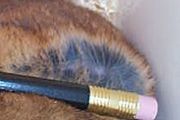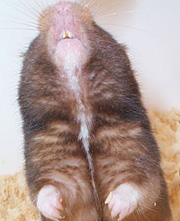
Contents
Genetics Index
The Basics
Chromosomes and
Genes
Dominant and Recessive,
Genotype and
Phenotype
Homozygous and
Heterozygous
Sex Chromosomes and
Sex Linkage
X-Inactivation
Mutation
Mutation Basics
Mutation in Syrians
Table of Mutations
Inheritance
Gametes
Punnett Square
Monohybrid Cross
Dihybrid Cross
Trihybrid Cross
Linkage
Sex Linkage
A Common
Misconception
Probability
The Nuts and Bolts
Examples
Principles of Breeding
Breeding Techniques
Dominant Traits
Recessive Traits
Epistasis
Lethality
Inadvisable Crosses
Lineal Purity v.
Heterogeneiry
Tortoiseshells and
Tricolors
Genotyping
Agouti v. Self
Basic Colors
The Golden Genotype
Combination Colors
Coat Types
Patterns
Eye Color
Ear Color
The Preliminary Genotype
Expanding the Genotype
• Parents
• Siblings
• Offspring
River Road Hamstery
(limited version)
Contact
|
Syrian Hamster Genetics: Genotyping Your Hamster The first step in discovering a hamster's genotype is to know its phenotype. Again, for full descriptions and photos of colors, coat types and patterns see the Pet Web Site, but here are a few guidelines to get you started.
There are eleven basic colors in Syrians, ten of which (excluding Golden) are determined by a single gene pair. All basic colors except Extreme Dilute are standardized (accepted for show).
In the above table the genotype of the Golden is indicated as ++, a standard way in genetics to indicate wild type. To write out the complete genotype of a Golden hamster carrying no mutant genes, every one of the many thousands of genes would need to be identified, issued a symbol and compiled in an exhaustive list. Just the 20 loci that have been presented here constitute a formidable chain. It would look like this: AA BB baba CC DgDg dsds EE HrHr LL lglg (By convention the genes are listed in alphabetical order.) Fortunately, most of this can be ignored, as it is only necessary to focus on a few genes at a time. Usually, the only ones noted are those that contain mutant alleles. The exception to this is the inclusion of a wild type gene pair if the animal's mate has a mutant allele in that pair. It's important to keep in mind though that even when the genes aren't mentioned, they do still exist in the hamster's chromosomes. Combination colors result from mutant genotypes at two or more loci in the same hamster. There are over a thousand different combinations of the eleven known genes that code for color. (The eleventh is the Umbrous gene. Not a color in itself, it usually modifies the other colors with a sooty grey wash over the entire coat. Umbrous changes Cream to a qualitatively different color, so combinations with both appear below.) The commonest and most established are shown in the table. Standard colors are in bold face. The "_" in a genotype indicates an allele that is not determined; e.g., eeU_ could be either eeUU or eeUu.
Coat type refers to the length and texture of the fur.
Certain genes inroduce various patterns onto the fur, beyond the anticipated Agouti or Self markings. All but one, the Tortoiseshell pattern, add white fur. Tortoiseshell is restricted to females.
Agouti eye color is black. Various shades of red, from bright pink to garnet, are produced by specific genotypes. The Dark Eared White phenotype has red eyes whether it is masking other colors or not. Cinnamon and all Cinnamon combinations have red eyes. A Ruby Eyed hamster has red eyes and a diluted coat color. (This gene is rare now and renders males sterile by 10 weeks of age.) The Dominant Spot gene can occasionally turn one or both eyes ruby or red when a white area surrounds the eye. The Anophthalmic White and Extreme Dilute genes can impart a red glow to the eyes when seen in a strong light. The ears of most Syrians are various shades of grey, deepening to black in Black hamsters. Inhibition of pigment deposition results in pale ears, ranging from light tan to peach to pink. Depigmented ears are part of the Cinnamon phenotype, alone or in combination with other colors. Mottled ears, where pale patches are mixed with grey, can occur in conjunction with any white pattern gene except Recessive Dappled. Occasionally, pattern genes can produce completely pale ears, most common when the animal has more than one pattern. Once you have figured out your hamster's phenotype, you can write a preliminary genotype. Here are a few quick examples. ("_" stands for "unknown.")
More information about your hamster's genotype can be gathered by looking at its parents, siblings and offspring. Phenotyping your hamster provides genotype information about recessive genes only if they are present in pairs; it does not tell you if the animal is carrying recessives. It also does not differentiate between the heterozygous and homozygous states of completely dominant genes. One method to help fill in the blanks is to look at the hamster's parents. Simply put, if a parent has a recessive trait not found in the animal under question, that animal will carry the gene for the trait. So if your Golden has a Black Eyed Cream parent, it must be split for Cream, and you can add Ee to its genotype. The presence of a trait dictated by a completely dominant gene that is lacking in one of the parents means that the animal is heterozygous for that trait. If one of your Banded Cinnamon's parents is nonbanded, then its genotype at the Banded locus must be Baba, not BaBa Information gathered from siblings is less definitive, but still can be helpful. The situation often arises in pet shop litters where a group of hamsters is known to be from the same litter, but information on the parents is unavailable. If most of the litter shows a dominant trait, and just a few are recessive, then there is around a 3 out of 4 chance that a dominant trait individual is a carrier. (These numbers reflect the uncertainty of the parental types. Both parents could have been heterozygous, or one could have been heterozygous and the other homozygous recessive.) If 1/2 or more are recessive, it is almost certain that the dominant trait animals carry. Applying this — in a litter of 6 Goldens and 2 Blacks where the parents are unknown, the Goldens have about a 75% chance of carrying Black. In a litter of 3 Goldens and 4 Blacks, the chance of a Golden being split for Black is close to 95%. It doesn't matter whether the gene under consideration is mutant or not. For example, in a mixed litter of Umbrous types (maybe Sable and Mink) and Nonumbrous types (Black Eyed Cream and Red Eyed Cream), fewer Umbrous animals correlates with a higher chance that they are heterozygous. Breeding an animal can provide more data about its genetic make-up. It is especially useful as a tool to confirm suspicions of heterozygosity. For any trait that may be heterozygous, breed to an animal that is homozygous recessive. Suppose you have an Umbrous Golden that you think, from looking at its siblings, may carry Black Eyed Cream and Cinnamon. Breeding it to a Red Eyed Cream can clarify the genotype at all three loci. For every gene pair that is heterozygous, the recessive trait is highly likely to appear in the litter, either alone or in combination. Sometimes, the offspring answer questions that were not even asked. Once, we bred a Black Eyed Cream to a Cinnamon, expecting a Golden litter but thinking that we might get Black Eyed Cream, Cinnamon and Red Eyed Cream. This would depend on each parent being split for the other's color. The litter contained all four colors — plus Mink, Umbrous Golden and Sable. After a much closer look at the Cinnamon mother, we realized that she had a very faint grey cast to her crescents and belly. She was Umbrous. The genotype of a Dark Eared White is difficult to figure out because of masking. Pairing it with an unpatterned animal unlikely to carry Dark Eared White should reveal any of the dominant pattern genes. If the pedigree of the White shows that it may carry recessive genes or have masked recessive colors, breed to an animal with that trait (again, one that is unlikely to carry Dark Eared White). If the pedigree shows that there may be dominant colors masked, breed to any animal not having those colors (or the Dark Eared White gene). With colors that are often confused, appropriate breeding can help sort it out. This can happen with the Greys, especially if the Grey is in combination (for instance, in the Grey Sables or Black Eyed Ivories). Breeding to any hamster without grey in its pedigree will give a good indication of the genotype. In the above cases, it also helps if the mate has no Cream or Umbrous genes. Dark Grey will not appear in the first generation; Light and Silver Greys will. If they are no longer in combination colors, phenotype should provide more clues. This is the end of the genetics tutorial. |

No part of this website may be reproduced in any form or by any means
without the prior written consent of the owner.
 The Golden hamster is the wild type of the species. Besides the typical golden brown color, it has agouti markings - cheekflashes, crescents, a chestband and a light colored underside. Also, the hairs of the fur have bands of different color, usually lighter in the middle section. Rusts, the three Greys, Cinnamons, Yellows, Extreme Dilutes and, of course, Goldens all have agouti markings.
The Golden hamster is the wild type of the species. Besides the typical golden brown color, it has agouti markings - cheekflashes, crescents, a chestband and a light colored underside. Also, the hairs of the fur have bands of different color, usually lighter in the middle section. Rusts, the three Greys, Cinnamons, Yellows, Extreme Dilutes and, of course, Goldens all have agouti markings. Hamsters without these features are called Self-colored hamsters, or Selfs. They often have a white chin, white chest stripe or patch, white belly patch and white feet. Selfs include Blacks, Black Eyed Creams and Dark Eared Whites. Any combination color that incorporates one or more the the self colors will also be Self. Most Self-colored hamsters have a single color in the coat hair that extends from the base to the tips. A few (notably Sable, Copper, Sable Chocolate and Yellow Black) have a bicolor hair, but it is unlike the tricolor pigment distribution in the Agouti hair.
Hamsters without these features are called Self-colored hamsters, or Selfs. They often have a white chin, white chest stripe or patch, white belly patch and white feet. Selfs include Blacks, Black Eyed Creams and Dark Eared Whites. Any combination color that incorporates one or more the the self colors will also be Self. Most Self-colored hamsters have a single color in the coat hair that extends from the base to the tips. A few (notably Sable, Copper, Sable Chocolate and Yellow Black) have a bicolor hair, but it is unlike the tricolor pigment distribution in the Agouti hair.